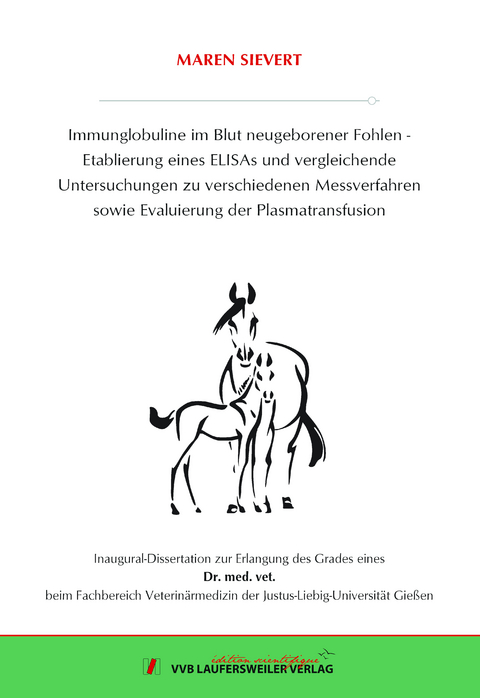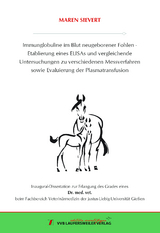Immunglobuline im Blut neugeborener Fohlen - Etablierung eines ELISAs und vergleichende Untersuchungen zu verschiedenen Messverfahren sowie Evaluierung der Plasmatransfusion
Seiten
2023
VVB Laufersweiler Verlag
978-3-8359-7108-0 (ISBN)
VVB Laufersweiler Verlag
978-3-8359-7108-0 (ISBN)
- Keine Verlagsinformationen verfügbar
- Artikel merken
Ziel dieser Arbeit war es, das bestmöglichste, schnell durchführbare Testverfahren, um eine HGG beim neonatalen Fohlen zu diagnostizieren, zu bestimmen und den Verlauf der Serum-IgG-Konzentration nach einer Plasmatransfusion darzulegen. Dazu wurden zwei unterschiedliche Studien durchgeführt.
In die erste Studie wurden 119 Fohlen in einem Alter von ein bis sechs Tagen einbezogen. Diese befasste sich mit der Evaluierung und Bewertung von drei schnell durchführbaren Testverfahren zur Diagnose einer HGG. Untersucht wurden der SNAP-Test, die Totalprotein-Bestimmung und die Bestimmung von TP-A. Die Ergebnisse wurden mit einem in-house entwickelten quantitativen ELISA als Referenzmethode verglichen. Die zweite Studie untersuchte den Verlauf der Serum-IgG-Konzentration nach einer Plasmatransfusion von neugeborenen Fohlen. Dazu wurden 23 Fohlen untersucht, die ein Alter von 24 bis 72 Stunden aufwiesen und mit einer Plasmatransfusion behandelt wurden. Die Serum-IgG-Konzentrationen wurden zu den Zeitpunkten vor der Transfusion, eine Stunde und 24 Stunden nach der Transfusion gemessen.
Folgende relevante Ergebnisse konnten in den beiden Studien erzielt werden:
- Die erste Studie zeigte, dass der SNAP-Test, die Bestimmung des TPs und die Berechnung von TP-A im Vergleich zum ELISA als Referenzmethode bei der Bestimmung der IgG-Konzentration ≥800 mg/dl ähnlich gute Werte lieferten. Auf der Grundlage der 95%igen Konfidenzintervalle scheinen der SNAP-Test und die Berechnung von TP-A ähnlich gut, aber besser als die Bestimmung des TPs für die Erkennung von IgG-Konzentrationen <400 mg/dl zu funktionieren.
¬ In der zweiten Studie konnte festgestellt werden, dass die Transfusion von 1 mg IgG eine durchschnittliche Erhöhung des Serum-IgG-Spiegels von 0,03 mg/dl (0.001-0.268 mg/dl) bewirkte. Führte man die Kontrolle des Serum-IgG-Spiegels nach 24 Stunden durch, verursachte die gleiche Menge einen Anstieg von 0,05 mg/dl (0.002-0.537 mg/dl). Ca. 22 % der Fohlen zeigten keinen messbaren Anstieg der Serum-IgG-Konzentration nach der Plasmatransfusion.
Somit konnte im Rahmen der vorliegenden Untersuchungen festgestellt werden, welches das geeignetste Testverfahren für eine schnelle Diagnose der Hypogammaglobulinämie ist. Weiterhin wurde gezeigt, dass neonatale Fohlen sehr individuell auf eine Plasmatransfusion reagieren und eine Folgemessung nach einer Plasmatransfusion unbedingt notwendig ist. The aim of this research work was to determine the best possible, rapid test procedure to diagnose HGG in the neonatal foal and to evaluate the course of serum IgG concentration after plasma transfusion. Two different studies were conducted for this purpose.
The first study involved 119 foals between one and six days of age. The study evaluated and assessed three rapid tests fort he diagnosis of hypogammaglobulinemia (HGG). The SNAP test, the total protein determination and the determination of TP-A were investigated. The results were compared with an in-house developed quantitative ELISA as a reference method. The second study investigated the course of serum IgG concentration after plasma transfusion of newborn foals. For this purpose, 23 foals with HGG were examined at an age of 24 to 72 hours and were treated with a plasma transfusion. Serum IgG concentrations were measured before transfusion and one hour as well as 24 hours after transfusion.
The following relevant results were obtained in the two studies:
The first study showed that the SNAP test, the determination of TP and the calculation of TP-A provided similarly good values compared to ELISA as the reference method in the determination of IgG concentration ≥800 mg/dl. Based on the 95% confidence intervals, the SNAP test and the calculation of TP-A appear to perform similarly well but better than the determination of TP fort he detection of IgG concentrations <400 mg/dl.
In the second study, it was found that transfusion of 1 mg IgG caused an average increase in serum IgG level of 0.03 mg/dl (0.001-0.268 mg/dl). When the serum IgG level was controlled after 24 hours, the same amount caused an increase of 0.05 mg/dl (0.002-0.537 mg/dl). Approximately 22% oft he foals showed no measurable increase in serum IgG concentration after plasma transfusion.
Based on these study results it was possible to determine which ist he most suitable test for a rapid diagnosis of hypogammaglobulinemia. Furthermore, it was shown that neonatal foals react very individually to a plasma transfusion and that a follow-up measurement after a plasma transfusion is absolutely necessary.
In die erste Studie wurden 119 Fohlen in einem Alter von ein bis sechs Tagen einbezogen. Diese befasste sich mit der Evaluierung und Bewertung von drei schnell durchführbaren Testverfahren zur Diagnose einer HGG. Untersucht wurden der SNAP-Test, die Totalprotein-Bestimmung und die Bestimmung von TP-A. Die Ergebnisse wurden mit einem in-house entwickelten quantitativen ELISA als Referenzmethode verglichen. Die zweite Studie untersuchte den Verlauf der Serum-IgG-Konzentration nach einer Plasmatransfusion von neugeborenen Fohlen. Dazu wurden 23 Fohlen untersucht, die ein Alter von 24 bis 72 Stunden aufwiesen und mit einer Plasmatransfusion behandelt wurden. Die Serum-IgG-Konzentrationen wurden zu den Zeitpunkten vor der Transfusion, eine Stunde und 24 Stunden nach der Transfusion gemessen.
Folgende relevante Ergebnisse konnten in den beiden Studien erzielt werden:
- Die erste Studie zeigte, dass der SNAP-Test, die Bestimmung des TPs und die Berechnung von TP-A im Vergleich zum ELISA als Referenzmethode bei der Bestimmung der IgG-Konzentration ≥800 mg/dl ähnlich gute Werte lieferten. Auf der Grundlage der 95%igen Konfidenzintervalle scheinen der SNAP-Test und die Berechnung von TP-A ähnlich gut, aber besser als die Bestimmung des TPs für die Erkennung von IgG-Konzentrationen <400 mg/dl zu funktionieren.
¬ In der zweiten Studie konnte festgestellt werden, dass die Transfusion von 1 mg IgG eine durchschnittliche Erhöhung des Serum-IgG-Spiegels von 0,03 mg/dl (0.001-0.268 mg/dl) bewirkte. Führte man die Kontrolle des Serum-IgG-Spiegels nach 24 Stunden durch, verursachte die gleiche Menge einen Anstieg von 0,05 mg/dl (0.002-0.537 mg/dl). Ca. 22 % der Fohlen zeigten keinen messbaren Anstieg der Serum-IgG-Konzentration nach der Plasmatransfusion.
Somit konnte im Rahmen der vorliegenden Untersuchungen festgestellt werden, welches das geeignetste Testverfahren für eine schnelle Diagnose der Hypogammaglobulinämie ist. Weiterhin wurde gezeigt, dass neonatale Fohlen sehr individuell auf eine Plasmatransfusion reagieren und eine Folgemessung nach einer Plasmatransfusion unbedingt notwendig ist. The aim of this research work was to determine the best possible, rapid test procedure to diagnose HGG in the neonatal foal and to evaluate the course of serum IgG concentration after plasma transfusion. Two different studies were conducted for this purpose.
The first study involved 119 foals between one and six days of age. The study evaluated and assessed three rapid tests fort he diagnosis of hypogammaglobulinemia (HGG). The SNAP test, the total protein determination and the determination of TP-A were investigated. The results were compared with an in-house developed quantitative ELISA as a reference method. The second study investigated the course of serum IgG concentration after plasma transfusion of newborn foals. For this purpose, 23 foals with HGG were examined at an age of 24 to 72 hours and were treated with a plasma transfusion. Serum IgG concentrations were measured before transfusion and one hour as well as 24 hours after transfusion.
The following relevant results were obtained in the two studies:
The first study showed that the SNAP test, the determination of TP and the calculation of TP-A provided similarly good values compared to ELISA as the reference method in the determination of IgG concentration ≥800 mg/dl. Based on the 95% confidence intervals, the SNAP test and the calculation of TP-A appear to perform similarly well but better than the determination of TP fort he detection of IgG concentrations <400 mg/dl.
In the second study, it was found that transfusion of 1 mg IgG caused an average increase in serum IgG level of 0.03 mg/dl (0.001-0.268 mg/dl). When the serum IgG level was controlled after 24 hours, the same amount caused an increase of 0.05 mg/dl (0.002-0.537 mg/dl). Approximately 22% oft he foals showed no measurable increase in serum IgG concentration after plasma transfusion.
Based on these study results it was possible to determine which ist he most suitable test for a rapid diagnosis of hypogammaglobulinemia. Furthermore, it was shown that neonatal foals react very individually to a plasma transfusion and that a follow-up measurement after a plasma transfusion is absolutely necessary.
| Erscheinungsdatum | 24.03.2023 |
|---|---|
| Reihe/Serie | Edition Scientifique |
| Verlagsort | Gießen |
| Sprache | deutsch |
| Maße | 148 x 210 mm |
| Themenwelt | Veterinärmedizin ► Allgemein |
| Veterinärmedizin ► Großtier | |
| Veterinärmedizin ► Pferd | |
| Schlagworte | Fohlen • Immunglobuline • Plasmatransfusion |
| ISBN-10 | 3-8359-7108-5 / 3835971085 |
| ISBN-13 | 978-3-8359-7108-0 / 9783835971080 |
| Zustand | Neuware |
| Informationen gemäß Produktsicherheitsverordnung (GPSR) | |
| Haben Sie eine Frage zum Produkt? |

